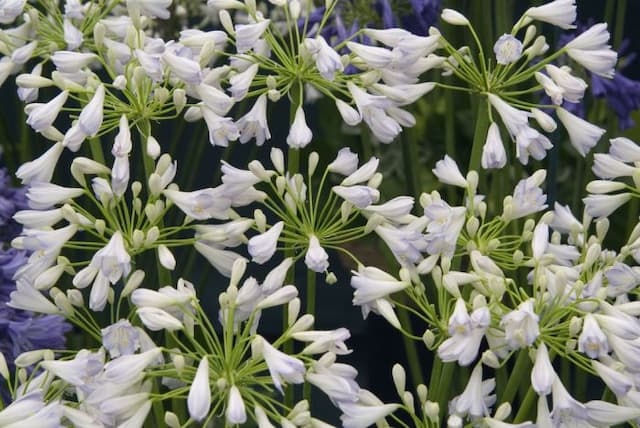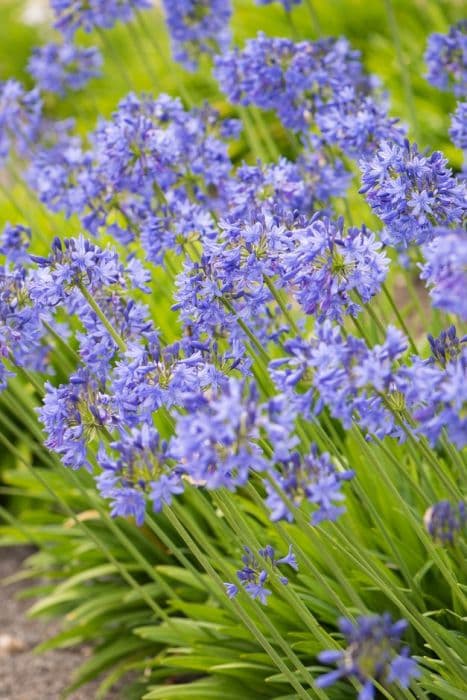Lily of the Nile Agapanthus 'Gold Strike' (PBR) (v)

ABOUT
The Agapanthus 'Gold Strike', commonly known as Lily of the Nile, is a striking perennial known for its decorative foliage and appealing flowers. It bears lush, strap-like leaves that form a dense clump, distinctive for their broad golden edges that contrast beautifully with a rich green center, creating a vibrant display of variegation throughout the plant. During its blooming season, the Agapanthus 'Gold Strike' produces tall, sturdy stems topped with rounded clusters of trumpet-shaped flowers. The blossoms, typically found in shades of blue or purple, are arranged in spherical umbels, resembling fireworks in their form. The flowers are known for their lasting quality and their ability to add a pop of color to any garden or landscape. The overall appearance of this Agapanthus cultivar is one of structured elegance, with its variegated foliage complementing the bold blooms, adding texture and a visual appeal that enhances garden beds, borders, and container plantings.
About this plant
 Names
NamesFamily
Amaryllidaceae
Synonyms
African Lily, Lily of the Nile, Love Flower
Common names
Agapanthus 'Gold Strike'
 Toxicity
ToxicityTo humans
The Lily of the Nile is known to be mildly toxic if ingested. Consumption of parts of the plant, particularly the roots and leaves, can result in symptoms such as nausea, vomiting, and diarrhea. In some cases, skin contact with the sap can cause irritation or allergic reactions. To avoid any adverse effects, it is recommended that humans do not ingest any part of the plant.
To pets
The Lily of the Nile is toxic to pets, including dogs and cats. If ingested, the toxicity can cause symptoms such as vomiting, nausea, abdominal pain, and diarrhea. In severe cases, it can lead to tremors or cardiac issues. If you suspect your pet has ingested any part of this plant, you should contact your veterinarian immediately.
 Characteristics
CharacteristicsLife cycle
Perennials
Foliage type
Evergreen
Color of leaves
Variegated
Flower color
Blue
Height
2 feet [60 cm]
Spread
2 feet [60 cm]
Plant type
Bulb
Hardiness zones
8
Native area
South Africa
Benefits
 General Benefits
General Benefits- Attractive Foliage: Agapanthus 'Gold Strike' has variegated leaves with golden-yellow margins, which add a colorful accent to the garden throughout the growing season.
- Drought Tolerant: Once established, it is quite drought-tolerant, making it suitable for xeriscaping or areas with water restrictions.
- Long Blooming Period: It produces flowers over a long period in the summer, offering visual interest for an extended time.
- Low Maintenance: Agapanthus 'Gold Strike' requires minimal care, making it an excellent choice for gardeners who desire an attractive garden without extensive upkeep.
- Attracts Wildlife: The blooms of the plant attract butterflies and bees, which are essential for pollination and maintaining a healthy ecosystem.
- Architectural Interest: The tall flower stalks and striking blooms add an architectural element to garden beds or borders.
- Container Suitability: It can be successfully grown in containers, making it versatile for patios, balconies, and other areas where garden space is limited.
- Tolerates Coastal Conditions: Agapanthus 'Gold Strike' is capable of withstanding salty winds and sandy soils, which often makes it a good choice for coastal gardens.
 Medical Properties
Medical PropertiesThis plant is not used for medical purposes.
 Air-purifying Qualities
Air-purifying QualitiesThis plant is not specifically known for air purifying qualities.
 Other Uses
Other Uses- As a natural dye - The sap and flowers of the Agapanthus may be used to create a natural blue or purplish dye for fabrics or artisanal crafts.
- Photography - With their striking blue to purple flowers, they can serve as a superb subject for botanical photographers or artists.
- Education - Agapanthus can be used to teach botany students about monocotyledonous plant structure and reproduction.
- Culinary decoration - Although not commonly consumed, the flowers can be used as an ornamental addition to dishes in high-end culinary presentations.
- Ice cubes - Freeze small Agapanthus flowers into ice cubes for a decorative touch in drinks at special events.
- Papermaking - The fibrous leaves of Agapanthus may be pulped and used in the process of handmaking paper.
- Eco-friendly confetti - Dried petals of Agapanthus can be used as biodegradable confetti for outdoor celebrations.
- Fish ponds - Agapanthus can serve as a decorative plant around fish ponds, offering shade and shelter for aquatic life.
- Bookmark decoration - Pressed Agapanthus flowers can be used in crafting bookmarks, providing a unique appearance and a touch of nature.
- Insect-repelling potpourri - Dried Agapanthus flowers can be mixed with other botanicals to create a natural insect-repellent potpourri.
Interesting Facts
 Feng Shui
Feng ShuiThe African Lily is not used in Feng Shui practice.
 Zodiac Sign Compitability
Zodiac Sign CompitabilityThe African Lily is not used in astrology practice.
 Plant Symbolism
Plant Symbolism- Love Letters: Agapanthus is derived from the Greek words 'agape,' meaning love, and 'anthos,' meaning flower. It can symbolize love or a message of love.
- Beauty: The striking blue or purple flowers of the African Lily symbolize beauty and fine appearance.
- Fertility: As a plant that can grow in groups and multiply, the African Lily is often associated with fertility and creation.
- Endurance: The African Lily's ability to withstand harsh conditions and still produce vibrant flowers represents endurance and perseverance.
- Purity: The lush and vivid blooms of the African Lily can signify purity and the innocence of heartfelt emotions.
 Water
WaterLily of the Nile, or Agapanthus 'Gold Strike', should be watered deeply but infrequently to mimic the natural rainfall pattern it would experience in its native environment. The plant prefers to dry out slightly between waterings. During the growing season, typically spring and summer, water every 7 to 10 days, providing about 1 gallon of water per plant. Reduce watering in the fall and further in the winter to monthly intervals, or even less if it rains. It's essential to ensure the plant is not left in soggy soil, so well-draining soil is a must to avoid root rot.
 Light
LightLily of the Nile thrives in full sunlight for optimal growth and blooms. Situate the plant in a spot where it will receive at least six hours of direct sunlight daily. While it can tolerate some partial shade, too little light may result in fewer flowers and leggy growth. Avoid deeply shaded areas, as insufficient light will negatively impact the plant's health and flowering capability.
 Temperature
TemperatureLily of the Nile prefers temperate climates and typically does well in temperatures ranging from 50 to 90°F. The plant is hardy in zones 8-10 and can survive brief periods of cold down to about 25°F, though it will die back to the ground in freezing temperatures and return in spring. The ideal temperature for the plant is between 70 and 80°F during the growing season for best growth and flowering.
 Pruning
PruningPruning Lily of the Nile helps to maintain its shape and encourages more vigorous blooms the following season. Deadheading spent flowers can promote a second bloom in late summer or early fall. Prune back the foliage to the ground in late fall or early winter after it has died back, which helps to tidy the plant and prevent fungal diseases. The best time for pruning is once the flowers have faded and the leaves begin to yellow or right before new growth starts in the spring.
 Cleaning
CleaningAs needed
 Soil
SoilLily of the Nile prefers well-draining soil with a loamy texture, enriched with organic matter. The best soil mix consists of two parts garden soil, one part peat moss or compost, and one part perlite or coarse sand for drainage. The pH should be slightly acidic to neutral, ideally between 6.0 and 7.0.
 Repotting
RepottingLily of the Nile should be repotted every 2 to 3 years to replenish the soil and provide room for growth. Divide clumps if necessary during repotting to prevent overcrowding and to propagate new plants.
 Humidity & Misting
Humidity & MistingLily of the Nile thrives in moderate to high humidity levels but is adaptable to typical outdoor humidity. Indoor plants benefit from occasional misting if the air is too dry, particularly in heated indoor environments.
 Suitable locations
Suitable locationsIndoor
Place Lily of the Nile near a sunny window, and water regularly.
Outdoor
Plant Lily of the Nile in full sun to part shade and well-draining soil.
Hardiness zone
8-11 USDA
 Life cycle
Life cycleAgapanthus 'Gold Strike', commonly known as the Gold Strike African Lily, begins its life as a seed, which germinates in moist, well-drained soil under full sun to partial shade conditions. Once the seedling emerges, it develops into a vegetative state characterized by strappy, green leaves with bold, creamy-yellow margins. The plant matures and enters the flowering stage during the summer months, producing tall stalks topped with rounded clusters of funnel-shaped, blue flowers. After blooming, the flowers may give way to seed pods if pollinators have visited, completing the reproductive cycle. The plant then enters a period of dormancy in colder climates, or may remain evergreen in milder regions, where it conserves energy for the next growing season. With proper care, including division of crowded clumps every few years, the Agapanthus 'Gold Strike' can thrive and repeat this life cycle for many years.
 Propogation
PropogationPropogation time
Spring-Summer
Agapanthus 'Gold Strike', commonly known as the African Lily, can be propagated by dividing its rhizomes, which is a popular method due to its simplicity and effectiveness. The best time for this activity is early spring or after the plant has finished flowering in the late summer or early fall. To propagate, carefully dig up the clump of the plant, ensuring you take as much of the root system with you as possible. Gently separate the rhizomes, making sure that each division has at least one or two growing points or shoots. These divisions can then be immediately replanted into well-draining soil at the same depth they were growing previously, spaced about 12 to 18 inches (approximately 30 to 45 centimeters) apart to allow sufficient room for growth. Water the newly planted divisions thoroughly to establish them in their new location. This method allows gardeners to create new plants that are genetically identical to the parent and it often rejuvenates older clumps that may have become too dense.









